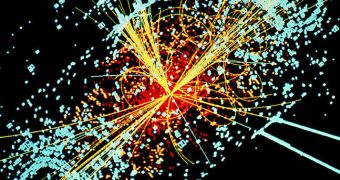Italian physicists have just submitted a new research paper for peer review, saying that they have uncovered evidence suggesting that elementary particles called neutrinos travel faster than photons.
The implications of their findings are mind-boggling, as they deny the main principle in Albert Einstein's theory of general relativity, therefore removing the solid foundation of modern physics.
Nearly a century ago, the famed physicist proposed that nothing travels faster than a photon in a vacuum, a constant speed of 299,792,458 meters (983,571,056 feet) per second. Even our current understanding of the Universe relies heavily on this principle.
Though several voices in the international scientific community have already expressed reluctance that the new data will stand scrutiny, the Italian team manning the Oscillation Project with Emulsion-tRacking Apparatus (OPERA) experiment say that they double- and triple-checked their results.
Knowing full well the implications their proposal will have, they wanted to ensure that the results they submitted to scrutiny stood the most rigorous testing. The OPERA instrument is located 1,400 meters (4,953 feet) underground in the Gran Sasso National Laboratory, in Italy.
Its experiments revolve around analyzing how fast beams of neutrinos produced by the European Organization for Nuclear Research's (CERN) Large Hadron Collider (LHC) – located 730 kilometers (453.6 miles) away – reach OPERA's sensitive detectors.
Neutrinos – as their name suggests – rarely interact with regular matter. They have a nearly-zero mass, and no electrical charge, so they are not influenced by the medium through which they travel. In the Universe, they pass unaffected through stars and black holes.
What the Italian group observed is that neutrinos released by the LHC reached OPERA detectors about 60 nanoseconds faster than the speed of light limitation allowed for. “We are shocked,” University of Bern physicist and OPERA spokesman Antonio Ereditato said.
The team's results were presented today at a meeting held at CERN. Preliminary results were posted on the physics website and online journal arXiv, so that physicists around the world can scan the results and attempt to find any mistakes that may have slipped in.
“If it's true, then it's truly extraordinary,” CERN theoretical physicist John Ellis said. According to Ereditato, the findings have a degree of certainty of six-sigma, which is the maximum scientists can apply to a discovery.
The Main Injector Neutrino Oscillation Search (MINOS) experiment in Minnesota saw a similar occurrence back in 2007, but physicists there did not come forth with the results because of the high degree of uncertainty their instruments displayed.
Over the coming months, physicists will be focused on verifying the results. At this point, very few dare to contemplate the massive theoretical reviews that will have to be made to countless scientific field if the data holds to scrutiny, Nature News reports.

 14 DAY TRIAL //
14 DAY TRIAL //